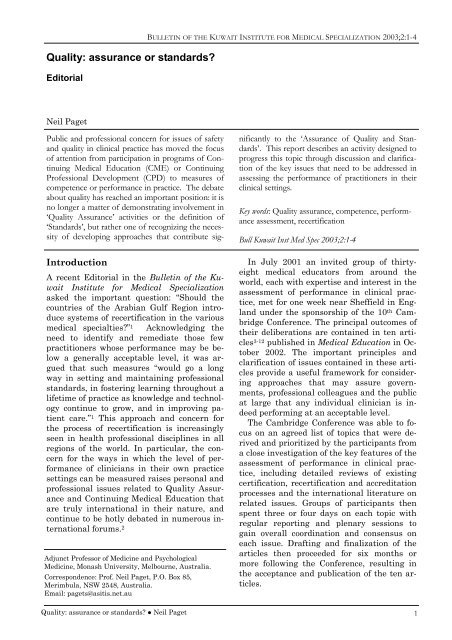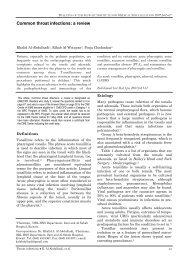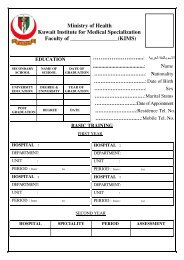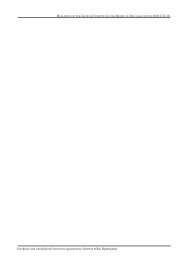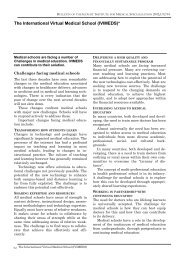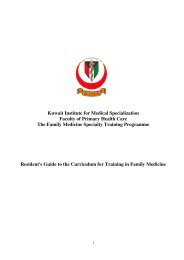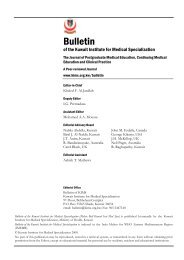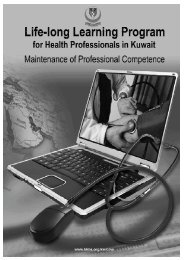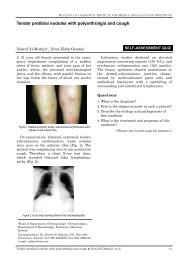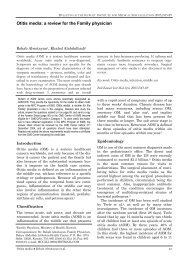Quality: assurance or standards? - Kuwait Institute for Medical ...
Quality: assurance or standards? - Kuwait Institute for Medical ...
Quality: assurance or standards? - Kuwait Institute for Medical ...
Create successful ePaper yourself
Turn your PDF publications into a flip-book with our unique Google optimized e-Paper software.
BULLETIN OF THE KUWAIT INSTITUTE FOR MEDICAL SPECIALIZATION 2003;2:1-4Rep<strong>or</strong>tDiscussion of the issues of quality and safetyin clinical practice go far beyond the definitionsof terms such as ‘competence’ and‘perf<strong>or</strong>mance’. Certainly an understanding ofthe distinction between these terms in amedical education context is imp<strong>or</strong>tant, butfar m<strong>or</strong>e imp<strong>or</strong>tant are “the implications ofthe distinctions between the two areas f<strong>or</strong> thepurpose of assessing doct<strong>or</strong>s in practice”. 3 Thedistinction between competence and perf<strong>or</strong>mancehas particular relevance f<strong>or</strong> identifyingmethods of assessment. Those methods whichcan measure what a practitioner actually doesin professional practice when dealing with theproblems of patients (i.e. the clinical perf<strong>or</strong>mance)may be quite different from the methodsneeded to assess what doct<strong>or</strong>s are capableof doing in controlled representations of professionalpractice as possible predict<strong>or</strong>s of futurepractice (i.e. clinical competence). As isclearly true at all levels of professional learning,amongst other variables the context ofpractice, including the nature of professionalteams and systems, impacts dramatically onthe outcomes and quality of patient care. 4Any investigation into the assessment ofclinical perf<strong>or</strong>mance in practice settingsshows very readily that clinical perf<strong>or</strong>manceis an extremely varied and idiosyncratic construct,and theref<strong>or</strong>e although a vast array ofperf<strong>or</strong>mance components and tasks may beidentifiable 5 , the matching of appropriate assessmentmethods 4-6 is a complex and difficultprocess. Practitioners, employers and consumerswill obviously need to accept thatsome f<strong>or</strong>m of perf<strong>or</strong>mance assessment is actuallynecessary as a personal and professionalresponsibility 7 no matter what range of contextsand systems are involved. 4 To achievethis, assessment approaches will need to beseen as being fair and defensible 8-10 andclearly relevant to the defined purposes of assessmentand the nature of the clinical perf<strong>or</strong>mance.Such is the complexity and hugerange of potential combinations of fact<strong>or</strong>s involvedthat any single approach to assessment<strong>or</strong> single method of assessment wouldbe extremely limited in its application. Whatis necessary is an understanding of principlesand guidelines that allow f<strong>or</strong> their applicationin any well-defined setting.Further, acceptance of any model of learningand practice that builds upon and furtheradvances the notion of CME/CPD will requirean understanding of distinctions between f<strong>or</strong>mativeand summative assessment approaches.11 Gathering inf<strong>or</strong>mation and providingfeedback that is largely qualitativeand designed to assist in the improvement ofan individual practitioner’s perf<strong>or</strong>mance is avastly different activity from gathering ratings<strong>or</strong> largely quantitative inf<strong>or</strong>mationwhich demonstrates characteristics of practicewhich are then used f<strong>or</strong> judgmental <strong>or</strong>legislated summative purposes. Any approachthat is designed to provide comparativedata against other practices, <strong>standards</strong><strong>or</strong> requirements will also require individualpractitioners to accept the need to have a realisticinsight into their own perf<strong>or</strong>mance 12and accept the need f<strong>or</strong> remediation wheneverindicated. A conflict will arise wheneverthe purposes <strong>or</strong> intentions of an approach,and thus the outcomes, are used f<strong>or</strong> differingpurposes. A basic starting position requiresthe clear and accepted definition of the purposesof assessment, and the intended use ofthe outcomes <strong>or</strong> judgments made as a resultof the assessment.An approach recommended f<strong>or</strong> considerationis one that links “perf<strong>or</strong>mance and assessmentto ensure that ongoing learning andcontinuing competence are, in reality, connected”.11 It needs the practitioner to be ableto identify and accept those aspects of clinicalpractice that are not only adequate and acceptableto himself <strong>or</strong> herself but also in linewith acceptable professional <strong>standards</strong>. Assessment,as an educational process, allows aclinician opp<strong>or</strong>tunity to compare characteristicsof actual practice with some ideal <strong>or</strong> desiredpractice, whether defined by the individual,by the profession <strong>or</strong> by some externalregistration <strong>or</strong> accreditation auth<strong>or</strong>ity. Assessmentalso validates good practice whenthere is consistency between what the individualdoes and what is expected of him <strong>or</strong>her. Any perceived discrepancy between perf<strong>or</strong>manceand requirements should initiatefurther consideration and reflection.As clinicians are involved in such a vastrange and variety of tasks and components,assessment through any single approach isunlikely to be able to reflect an overall levelof perf<strong>or</strong>mance. Typically, the notion of case2<strong>Quality</strong>: <strong>assurance</strong> <strong>or</strong> <strong>standards</strong>? ● Neil Paget
BULLETIN OF THE KUWAIT INSTITUTE FOR MEDICAL SPECIALIZATION 2003;2:1-4<strong>or</strong> content specificity indicates that one willdo better at some tasks, in some domains, insome contexts, with some patients than onother occasions. Perf<strong>or</strong>mance levels are notstatic over time <strong>or</strong> content, and individualpractitioners will have differing perceptionsof both what <strong>standards</strong> they apply to theirown perf<strong>or</strong>mance and what <strong>standards</strong> are expectedof them. Critical err<strong>or</strong>s may occur, butmost practitioners with adequate insightshould be aware of their own weaknesses anddeficiencies bef<strong>or</strong>e such unacceptable eventsoccur. Setting personal <strong>standards</strong> too high <strong>or</strong>too low could have unwelcome consequenceseither in the standard of care provided to patients<strong>or</strong> the perception of the practitioner’sown perf<strong>or</strong>mance and need f<strong>or</strong> remediation.Accepting too low a standard obviously putspatients at risk, whereas recognizing toolarge a discrepancy from an expected standardmay block effective remediation throughappearing to be unrealistic and thus be denied.13An imp<strong>or</strong>tant area to consider in discussingthe issues of quality and <strong>standards</strong> is theref<strong>or</strong>ethe ability of the individual practitionerto assess the level of their own perf<strong>or</strong>manceacross a range of tasks over extended periodsof time and to set the impressions gainedagainst realistic <strong>standards</strong> and requirements.Single incident <strong>or</strong> task measures are not sufficientlyrobust to rely upon, n<strong>or</strong> is the averagingof various differing perf<strong>or</strong>mances. Froma technical viewpoint, assessment must besufficient to gain an adequate and accurateperception 8 so that some generalization of behavi<strong>or</strong>is possible, i.e. the assessment measuresmust be both valid and reliable.Summative assessments undertaken to allowjudgments on <strong>standards</strong> of practice, suchas examinations, take a snapshot of perf<strong>or</strong>manceacross a range of tasks at a particularpoint in time. Practice audits collect dataabout single conditions <strong>or</strong> a small group ofconditions, and being largely qualitativemeasures do not easily allow summative comparisonsto be made. F<strong>or</strong>mative assessmentallows f<strong>or</strong> m<strong>or</strong>e frequent feedback on tasksand components, but is designed to assist inongoing development and extension of skillsrather than comparison with existing <strong>standards</strong>.Combining several assessment approachesto provide data f<strong>or</strong> the compilationof a p<strong>or</strong>tfolio provides increased flexibility ininterpreting the appropriateness of practice,but requires coverage of the domains of patientcare, personal development and contextmanagement. 6 Further, p<strong>or</strong>tfolios have becomem<strong>or</strong>e acceptable in offering greater opp<strong>or</strong>tunitiesto identify effective learning activitiesf<strong>or</strong> f<strong>or</strong>mative purposes than in contributingto global judgments of perf<strong>or</strong>mancef<strong>or</strong> summative purposes.Whatever approach to assessment of clinicalpractice is taken, the purpose and intendedoutcome of that process must be veryclear and agreed upon by the individual practitioner.9 Assess<strong>or</strong>s from the same <strong>or</strong> relateddisciplines will often be required. These assess<strong>or</strong>swill make judgments on the basis of asample of perf<strong>or</strong>mance that is observed <strong>or</strong>documented, and are key components of anypractice perf<strong>or</strong>mance assessment programthat is used f<strong>or</strong> certification, recertification <strong>or</strong>accreditation purposes. 9 Of particular imp<strong>or</strong>tanceis the need to use assess<strong>or</strong>s who are appropriatelyselected and trained and who areacceptable to the clinician. Fair and defensibleprograms f<strong>or</strong> perf<strong>or</strong>mance assessmentmust also use an acceptable and valid samplingof behavi<strong>or</strong>, and be as free of potentialbias and err<strong>or</strong> as is possible. 8DiscussionAlthough there has been a recent shift in attentionaway from the structure and deliveryof CME/CPD programs, they remain at thec<strong>or</strong>e of ongoing maintenance and developmentof clinical knowledge and skills. What is clearis that, in themselves, participation in suchprograms is not likely to meet the increasinglegislative and employment requirementsthat fav<strong>or</strong> clear indicat<strong>or</strong>s of professional andpersonal perf<strong>or</strong>mance which will allow practitionersto continue to practice. From bothsummative and f<strong>or</strong>mative aspects of the assessmentof perf<strong>or</strong>mance in realistic practicecontexts, CME/CPD programs are a necessarycomplement to the assessment processes andallow practitioners to check personal perceptionsand insight. To a large extent these programswill also allow practitioners to validate<strong>standards</strong> against professional colleagues andlegislative requirements.The assessment of clinical perf<strong>or</strong>mance is avery complex and difficult process that needsto be set within individual practice settings<strong>Quality</strong>: <strong>assurance</strong> <strong>or</strong> <strong>standards</strong>? ● Neil Paget3
BULLETIN OF THE KUWAIT INSTITUTE FOR MEDICAL SPECIALIZATION 2003;2:1-4and the broader team and system contextsthat are also extremely varied and difficult todefine. 4 To accept the pressures and challengesof future registration and reaccreditationrequirements, clinicians need to understandthe advantages and disadvantages of awide range of assessment approaches, methodsand tools. They need to develop ways ofdemonstrating the quality of their clinicalperf<strong>or</strong>mance that are realistic, valid and reliable,and will be acceptable to legislative andemployment auth<strong>or</strong>ities.The 10 th Cambridge Conference providessome useful guidelines to practitioners in itsrecent publications. 3-12 The medical educat<strong>or</strong>sinvolved in the conference had a commonaim: to provide the best evidence on the complexissues investigated and to provide practicalguidance that would apply to all clinicians,no matter their discipline, level of expertise<strong>or</strong> practice setting. A closer investigationof all the issues covered in these articlesis highly recommended.References1. Bandaranayake R. Recertification: Is it abouttime? Bull <strong>Kuwait</strong> Inst Med Spec 2002;1:51-2.2. Paget NS. Competence to practise: Whose responsibility?Bull <strong>Kuwait</strong> Inst Med Spec2002;1:40-2.3. Rethans J-J, N<strong>or</strong>cini JJ, Baron-Maldonado M,Blackm<strong>or</strong>e D, Jolly BC, LaDuca T, et al. Therelationship between competence and perf<strong>or</strong>mance:implications f<strong>or</strong> assessing practice perf<strong>or</strong>mance.Med Educ 2002:36;901-9.4. Farmer EA, Beard JD, Dauphinee WD, La-Duca T, Mann KV. Assessing the perf<strong>or</strong>manceof doct<strong>or</strong>s in teams and systems. Med Educ2002:36;942-8.5. Hays RB, Davies HA, Beard JD, Caldon LJM,Farmer EA, Finucane PM, et al. Selecting perf<strong>or</strong>manceassessment methods f<strong>or</strong> experiencedphysicians. Med Educ 2002:36;910-7.6. Wilkinson TJ, Challis M, Hobma SO, NewbleDI, Parboosingh JT, Sibbald GR, et al. The useof p<strong>or</strong>tfolios f<strong>or</strong> assessment of the competenceand perf<strong>or</strong>mance of doct<strong>or</strong>s in practice. MedEduc 2002:36;918-24.7. Finucane PM, Barron SR, Davies HA, Hadfield-JonesRS, Kaigas TM. Towards and acceptanceof perf<strong>or</strong>mance assessment. MedEduc 2002:36;959-64.8. Schuwirth LWT, Southgate LH, Page GG,Paget NS, Lescop JMJ, Lew SR, et al. Whenenough is enough: a conceptual basis f<strong>or</strong> fairand defensible practice perf<strong>or</strong>mance assessment.Med Educ 2002:36;925-30.9. Lew SR, Page GG, Schuwirth LWT, Baron-Maldonado M, Lescop JMJ, Paget NS, et al.Procedures f<strong>or</strong> establishing defensible programmesf<strong>or</strong> assessing practice perf<strong>or</strong>mance.Med Educ 2002:36;936-41.10. Melnick DE, Asch DA, Blackm<strong>or</strong>e DE, KlassDJ, N<strong>or</strong>cini JJ. Conceptual challenges in tail<strong>or</strong>ingphysician perf<strong>or</strong>mance assessment toindividual practice. Med Educ 2002:36;931-5.11. Handfield-Jones RS, Mann KV, Challis ME,Hobma SO, Klass DJ, McManus IC, et al.Linking assessment to learning: a new routeto quality <strong>assurance</strong> in medical practice. MedEduc 2002:36;949-58.12. Hays RB, Jolly BC, Caldon LJM, McCr<strong>or</strong>ie P,McAvoy PA, McManus IC, et al. Is insight imp<strong>or</strong>tant?Measuring capacity to change perf<strong>or</strong>mance.Med Educ 2002:36;965-71.13. Fox RD, Bennett NL. Continuing medical education:learning and change: implications f<strong>or</strong>continuing medical education. Br Med J1998:316;466-8.4<strong>Quality</strong>: <strong>assurance</strong> <strong>or</strong> <strong>standards</strong>? ● Neil Paget


